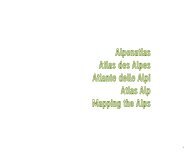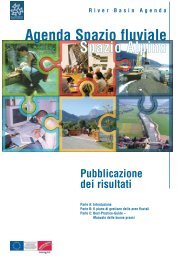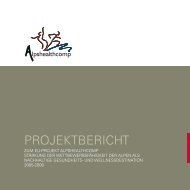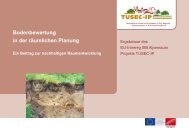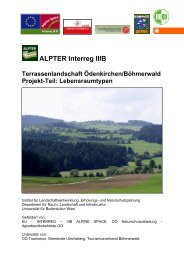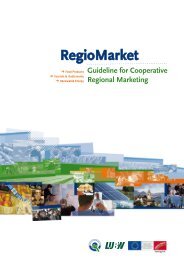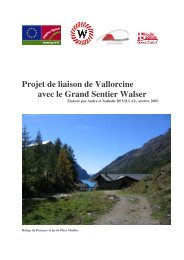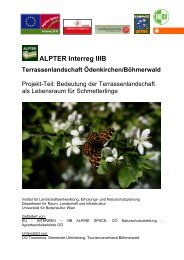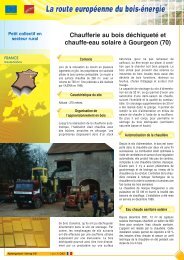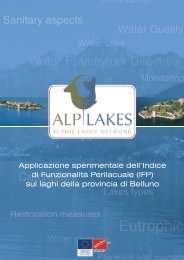1.2 - INTERREG IIIB Alpine Space Programme
1.2 - INTERREG IIIB Alpine Space Programme
1.2 - INTERREG IIIB Alpine Space Programme
Create successful ePaper yourself
Turn your PDF publications into a flip-book with our unique Google optimized e-Paper software.
66 3.2 Via Alpina<br />
environment and cultural heritage<br />
Lead partner<br />
Association Grande Traversée<br />
des Alpes<br />
Other partners<br />
Regione Piemonte<br />
Regione Lombardia<br />
Regione A. FVG<br />
Regione A. Valle d’Aosta<br />
Regione Liguria<br />
Regione Veneto<br />
Provincia A. di Bolzano<br />
Provincia A. di Trento<br />
OeAV<br />
DAV<br />
Schweizer Wanderwege<br />
Proplus d.o.o<br />
CAM<br />
AWNL<br />
Project website<br />
www.via-alpina.org<br />
Contact person<br />
Grégoire Bel<br />
Tel +33 (0)4 76 42 08 31<br />
Fax +33 (0)4 76 42 87 08<br />
interreg@via-alpina.org<br />
Duration<br />
0<strong>1.2</strong>001 – 12.2004<br />
Total budget in EUR<br />
2.488.085<br />
ERDF in EUR<br />
948.599<br />
Lead partner<br />
Project partner<br />
F<br />
I<br />
I<br />
I<br />
I<br />
I<br />
I<br />
I<br />
I<br />
A<br />
D<br />
CH<br />
SI<br />
MC<br />
FL<br />
Promoting the natural and cultural heritage of the Alps on a network of hiking trails.<br />
Aim<br />
So far only few initiatives in this field have been implemented<br />
with a trans-frontier strategy, and none at the level of the<br />
entire Alps. While all <strong>Alpine</strong> countries have set up a dense<br />
network of local, regional, national and even European hiking<br />
trails, Via Alpina is the first official route linking the eight <strong>Alpine</strong><br />
countries.<br />
Five international hiking routes, based exclusively on exist-<br />
ing trails, have been identified by the partners on the basis of<br />
tourism, environmental and strategic criteria. They aim at the<br />
international public and appealing not only to long-distance<br />
hikers but also to less-trained tourists.<br />
Activities<br />
This is a first phase, focussing on two fields of activity:<br />
Promotion: Creation and dissemination of a complete range<br />
of promotional tools: way-marking and information panels,<br />
website, brochures, festive events, press releases... This<br />
is based on an extensive database compiled by all partners<br />
and comprising practical information on the trails and<br />
services as well as references to the elements of cultural<br />
and natural heritage. Most documents have a transnational<br />
scope, promoting the entire <strong>Alpine</strong> space and are published<br />
in the four <strong>Alpine</strong> languages plus English.<br />
Technical exchange: Through meetings of the International<br />
steering committee, a professional newsletter and internet<br />
site, exchange of experience took place. Pilot studies were<br />
carried out on how to use the trail to stimulate local initiatives<br />
and improve quality of the offer and on the potential of information<br />
technology for marketing and trail management.<br />
Outcomes and results<br />
Creation of the visual identity of the trail throughout the <strong>Alpine</strong><br />
countries. The display of the general map of Via Alpina on<br />
more than 300 locations strongly contributes to the awareness<br />
of the dimension of the Alps and the strengthening of<br />
the <strong>Alpine</strong> identity.<br />
Production and dissemination of a series of common promo-<br />
tion instruments presenting the five Via Alpina itineraries:<br />
logo, database (texts, maps and illustrations) also provides<br />
a basis for the development of further tools (e.g. a series of<br />
guidebooks from private publishers), leaflets and brochures,<br />
interactive website, festive events, press work. Regional promotion<br />
tools complete those common promotion instruments.<br />
Most publications and the database are in five languages.<br />
Best practices gathered in a “quality guide” present recom-<br />
mendations and charters to improve the quality of services<br />
to hikers. It provides a basis for further actions in order to<br />
increase both the satisfaction of tourists and the economic<br />
impact on local communities.<br />
Via Alpina aims at becoming a permanent feature of <strong>Alpine</strong><br />
tourism and plays a structuring role for the development of<br />
hiking tourism. The project focuses on establishing the Via<br />
Alpina “product” and exploring further development methods.<br />
The analysis of feedback from the public, the results of the<br />
studies and pilot projects, and further ideas which have arisen<br />
from the networking activities have formed the basis for a<br />
second project phase in 2005-2007. The name of this second<br />
project is: Via Alpina Development Venture (Viadventure).



